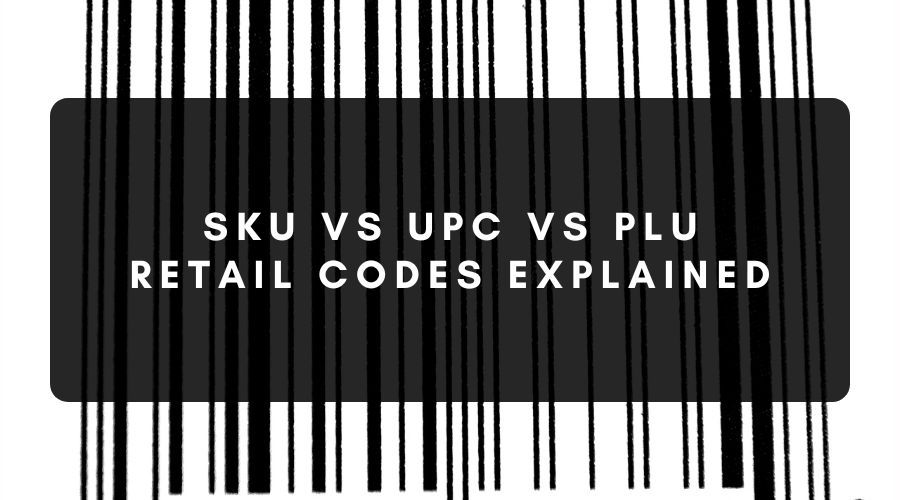
SKU vs UPC vs PLU – Retail Codes Explained
Keeping track of inventory and sales with SKU, UPC, and/or PLU codes is a key part of running a successful retail business. Effective inventory management ensures products are available when customers make purchases and allows e-commerce retail businesses to make informed decisions about restocking and forecasting.
SKU, UPC, and PLU codes are three distinct types of codes that are commonly used to identify products. These codes are vital for merchants to efficiently track and manage their inventory and ensure they’re always in a position to meet customer demand.
What Is a Stock-Keeping Unit (SKU)?
An SKU (stock-keeping unit) is an alphanumeric code created by the retailer. This code contains information such as a product’s brand, size, colour, and style. Retailers use SKUs for internal inventory management purposes, to track sales, and for restocking. In short, SKUs allow business owners to identify and organise the products in their database.
Advantages of Using SKUs
The following are some of the advantages of using SKU codes to manage inventory:
- SKUs allow businesses to create custom product identifiers that best cater to their unique requirements. A code that moulds to an individual business’s needs makes inventory management systems easier and inventory data analysis more efficient.
- SKUs optimise warehouse operations by streamlining inventory management. SKUs help businesses organise their products according to attributes like size, style, and colour.
- Businesses can better understand customer preferences and trends with the sales and inventory data provided by SKUs. This leads to well-informed decisions about product assortment and pricing strategies.
What Is a Universal Product Code (UPC)?
Universal product codes (UPCs) are 12-digit global trade item numbers (GTINs) accompanied by unique barcodes that are used to identify products at the point of sale. UPCs are used with products that remain the same regardless of who sells the product, where, or how it’s sold. UPCs are regulated by an international NGO called GS1. Companies that design a product can purchase a UPC for that product from GS1.
The 12-digit UPC code (also referred to as a 12-digit global trade item number) is broken down into three sections:
- The first 6-10 digits denote the company prefix. This identifies the business that owns the intellectual property rights to the product.
- The next 1-5 digits are chosen by the UPC owner.
- The final digit number is produced using a special formula based on the preceding 11 digits. The idea of this final number is to prevent the use of fake UPCs and assist with identifying printing errors.
A UPC barcode allows the retailer to retrieve pricing and inventory information by pinpointing information assigned to the product by the manufacturer. For example, in the food industry, UPCs allow retailers to identify sizes, volumes, flavours, and other variations of products. This information can be especially useful at the point of sale, for example when dealing with returns or checking if your store has a specific item in stock.
Important note: 13-digit European Article Numbers (EANs) are more commonly used in Europe whereas UPCs are primarily used in Canada and the United States. EANs feature a country code that precedes the 12-digit GTIN. Products that are sold in Canada and the United States begin with a zero in their EAN iteration.
Advantages of using UPC Barcodes
There are several advantages of using UPC barcodes in small retail or e-commerce businesses, including the following:
- UPCs allow businesses to track inventory efficiently. This makes it easier for companies to manage their stock and ensure accurate product counts.
- UPCs streamline operations between businesses as they offer a standardised way to identify products. This is especially important for retailers that work with multiple suppliers or manage large volumes of products.
- UPCs improve the accuracy of sales data. This enables retailers to make informed business decisions about pricing and promotions.
What Is a Price Look-Up Code (PLU Code)?
A price look-up code (PLU code) is another numeric code that identifies products in retail stores. However, unlike the other two codes, a PLU is primarily used in grocery stores and supermarkets.
You may have seen a sticker on fresh fruit or vegetables that includes a short, 4-6 digit code. This code allows cashiers to identify the product quickly, especially products that need to be weighed as they go through the checkout. PLU codes have been administrated by the International Federation for Produce Standards since 2001.
Advantages of PLU Codes
The following are some of the advantages of PLU codes:
- Numerical code: PLU codes only use numbers (no letters) and are short. This makes them easy to recognise and use.
- Fresh food-centric: PLU codes are primarily linked with fresh produce like fruit and vegetables. A PLU code can help the cashier distinguish similar products, like a conventionally vs organically produced banana.
- Pricing information: PLU codes are linked to pricing information in the store’s point-of-sale system. This makes the checkout process more efficient.
- Standardisation: PLU codes are universal, meaning the same code will be used for a specific item across different stores.
What Are the Main Differences Between an SKU vs UPC vs PLU Code?
All three code types play a vital role in managing inventories, tracking products, and streamlining supply chain operations. However, as PLU numbers are primarily used in supermarkets, SKU and UPC codes will be the most commonly used code types for businesses outside the food sector.
SKU |
UPC |
PLU |
|
| Code Type | Alphanumeric (numbers and letters) | Numeric code | Numeric code |
| Code Length | Any length (typically 8-10 characters) | 12 digits | 4-6 digits |
| Code Creator | Generated by the brand that designed the product | Must be purchased from GS1 | Universal code used around the world |
| Business-Specific or Universal? | Business-specific | Universally recognised | Universally recognised |
| Product Type | Physical products or services | Physical products | Fresh produce |
Which Do You Need?
Merchants are not required by law to use UPCs or SKUs in their shops. However, many retailers choose to use them to make inventory tracking and shipping processes more efficient. You may also need to use these codes to open new sales channels, for example, to sell in online marketplaces.
A UPC or SKU Isn’t Needed If You Sell Products:
- Directly to your customers, for example at markets or trade shows
- Directly through your own e-commerce website
- Though an online marketplace like eBay or Etsy
- To small, local retail stores that don’t require barcodes
A UPC or SKU Is Needed If You Sell Products:
- On Amazon
- On other online marketplaces that require them
- To large chain retailers like supermarkets or department stores
- To other retail stores that require barcodes
Centralisation of Retail Functions Is Essential
Regardless of the codes your business uses, centralised inventory management software and a centralised payment processing system are crucial. A merchant services account with an integrated global payment gateway and central dashboard allows businesses to oversee all their operations as and when they happen, centralising everything from inventory to sales and payment processing.
Set Your Retail Business Up for Success
Retail codes such as SKUs, UPCs, and PLUs streamline product identification for easier inventory management and clear communication between stores and departments. Your business type and sales channels will determine the kinds of codes you need to use.
Retail codes are only one part of centralising your sales data for informed decision-making. A centralised payment processing system coupled with an efficient inventory management system will give you the most complete dataset for making decisions that benefit your bottom line.
Published: May 9, 2024
Last updated: June 19, 2024

